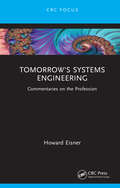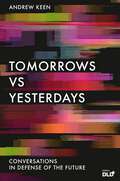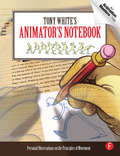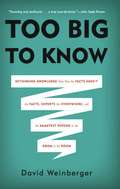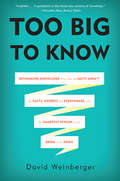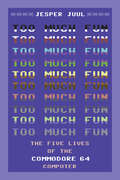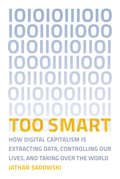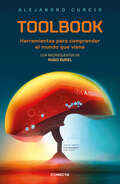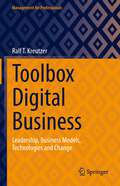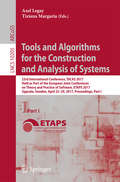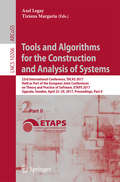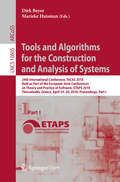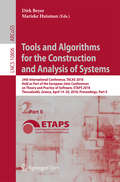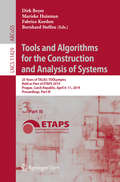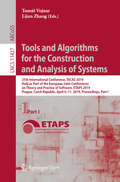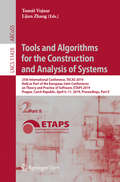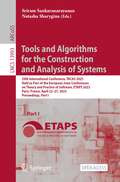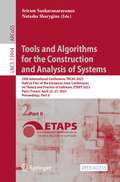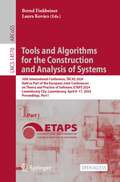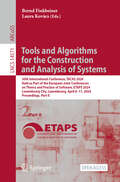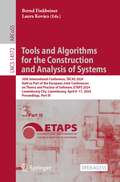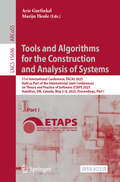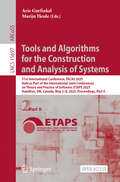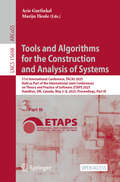- Table View
- List View
Tomorrow's Systems Engineering: Commentaries on the Profession
by Howard EisnerThis book looks at systems engineering now and comments on the future. It notes the signs of deepening our understanding of the field which includes, digital engineering, interactive model-based systems, decision support frameworks, and points to a grand unified theory. The book also suggests how the systems engineer can be a better designer and architect. Offering commentaries regarding how the field of systems engineering might evolve over the next couple of decades, Tomorrow’s Systems Engineering: Commentaries on the Profession looks at the potential opportunities that might lie ahead rather than making predictions for the future of the field. The book allows the reader to prepare for the future in terms of technical interest as well as competitiveness and suggests opportunities that could be significant and useful for planning actions in the careers of future systems engineers. Discussions of improvements in how we develop and use software that can help to facilitate and protect overall IT capability within the system design and system architecture are also included. This book is for systems engineers and software engineers who wish to think now about the directions the field might take in the next two decades.
Tomorrows Versus Yesterdays: Conversations in Defense of the Future
by Andrew KeenThe current crisis of democracy, the growing economic inequality between rich and poor, our narcissistic social media culture and the looming menace of AI all threaten us as never before. The challenges presented by technology have long been central in these issues, but how can we take advantage of the opportunities it provides to shape a better twenty-first century? The most important division of our age is between the 'tomorrows', those who believe that the future can be better than the past, and the 'yesterdays' who harbor a nostalgic desire to return to a rose-tinted past. This division is encapsulated by how we answer a simple question: can we trust the future?In Tomorrows Versus Yesterdays, Andrew Keen discusses the issue with some of the most influential thinkers of our time. The book is split into four sections. The first identifies the challenges of our digital age. The second focuses on the failure of the internet revolution to realize its ambitious goals. The third untangles the complex relationship between populism and digital media, before the final part presents possible solutions to the challenges of our age. The result is an insightful examination of the most important issues facing us today, and essential reading for anyone interested in the impact of the digital revolution.
Tony White's Animator's Notebook: Personal Observations on the Principles of Movement
by Tony WhiteApprentice yourself to a master of classical animation techniques with this beautiful handbook of insider tips and techniques. Apply age-old techniques to create flawless animations, whether you're working with pencil and animation paper or a 3D application.
Too Big to Know
by David WeinbergerWe used to know how to know. We got our answers from books or experts. WeOCOd nail down the facts and move on. But in the Internet age, knowledge has moved onto networks. ThereOCOs more knowledge than ever, of course, but itOCOs different. Topics have no boundaries, and nobody agrees on anything. Yet this is the greatest time in history to be a knowledge seeker . . . if you know how. In "Too Big to Know," Internet philosopher David Weinberger shows how business, science, education, and the government are learning to use networked knowledge to understand more than ever and to make smarter decisions than they could when they had to rely on mere books and experts. This groundbreaking book shakes the foundations of our concept of knowledge?from the role of facts to the value of books and the authority of experts?providing a compelling vision of the future of knowledge in a connected world. "
Too Big to Know: Rethinking Knowledge Now That the Facts Aren't the Facts, Experts Are Everywhere, and the Smartest Person in the Room Is the Room
by David WeinbergerWe used to know how to know. We got our answers from books or experts. We’d nail down the facts and move on. But in the Internet age, knowledge has moved onto networks. There’s more knowledge than ever, of course, but it’s different. Topics have no boundaries, and nobody agrees on anything. Yet this is the greatest time in history to be a knowledge seeker . . . if you know how. In Too Big to Know, Internet philosopher David Weinberger shows how business, science, education, and the government are learning to use networked knowledge to understand more than ever and to make smarter decisions than they could when they had to rely on mere books and experts. This groundbreaking book shakes the foundations of our concept of knowledge#151;from the role of facts to the value of books and the authority of experts#151;providing a compelling vision of the future of knowledge in a connected world.
Too Much Fun: The Five Lives of the Commodore 64 Computer (Platform Studies)
by Jesper JuulThe surprising history of the Commodore 64, the best-selling home computer of the 1980s—the machine that taught the world that computing should be fun.The Commodore 64 (C64) is officially the best-selling desktop computer model of all time, according to The Guinness Book of World Records. It was also, from 1985 to 1993, the platform for which most video games were made. But while it sold at least twice as many units as other home computers of its time, like the Apple II, ZX Spectrum, or Commodore Amiga, it is strangely forgotten in many computer histories. In Too Much Fun, Jesper Juul argues that the C64 was so popular because it was so versatile, a machine developers and users would reinvent again and again over the course of 40 years.First it was a serious computer, next a game computer, then a computer for technical brilliance (graphical demos using the machine in seemingly impossible ways), then a struggling competitor, and finally a retro device whose limitations are now charming. The C64, Juul shows, has been ignored by history because it was too much fun. Richly illustrated in full color, this book is the first in-depth examination of the C64’s design and history, and the first to integrate US and European histories. With interviews of Commodore engineers and with its insightful look at C64 games, music, and software, from Summer Games to International Karate to Simons’ BASIC, Too Much Fun will appeal to those who used a Commodore 64, those interested in the history of computing and video games and computational literacy, or just those who wish their technological devices would last longer.
Too Smart: How Digital Capitalism is Extracting Data, Controlling Our Lives, and Taking Over the World (The\mit Press Ser.)
by Jathan SadowskiWho benefits from smart technology? Whose interests are served when we trade our personal data for convenience and connectivity?Smart technology is everywhere: smart umbrellas that light up when rain is in the forecast; smart cars that relieve drivers of the drudgery of driving; smart toothbrushes that send your dental hygiene details to the cloud. Nothing is safe from smartification. In Too Smart, Jathan Sadowski looks at the proliferation of smart stuff in our lives and asks whether the tradeoff—exchanging our personal data for convenience and connectivity—is worth it. Who benefits from smart technology?Sadowski explains how data, once the purview of researchers and policy wonks, has become a form of capital. Smart technology, he argues, is driven by the dual imperatives of digital capitalism: extracting data from, and expanding control over, everything and everybody. He looks at three domains colonized by smart technologies' collection and control systems: the smart self, the smart home, and the smart city. The smart self involves more than self-tracking of steps walked and calories burned; it raises questions about what others do with our data and how they direct our behavior—whether or not we want them to. The smart home collects data about our habits that offer business a window into our domestic spaces. And the smart city, where these systems have space to grow, offers military-grade surveillance capabilities to local authorities. Technology gets smart from our data. We may enjoy the conveniences we get in return (the refrigerator says we're out of milk!), but, Sadowski argues, smart technology advances the interests of corporate technocratic power—and will continue to do so unless we demand oversight and ownership of our data.
Toolbook: Herramientas para comprender el mundo que viene
by Hugo Burel Alejandro CurcioHerramientas para comprender el mundo que viene La tecnología avanza como nunca y está redefiniendo la forma en que vivimos, trabajamos y nos comunicamos. La inteligencia artificial, la nanotecnología, la realidad virtual y mixta y la biotecnología son algunas de las áreas que impulsan estos cambios. Pero ¿de qué se trata todo esto y cómo funciona? ¿Cómo es que ya está repercutiendo en nuestro día a día? ¿Cómo podemos aprovecharlo a nuestro favor? ¿Qué oportunidades y qué retos se presentan? ¿Cuáles son los desafíos para las personas y las organizaciones? Este libro tiene vocación de manual para leer en clave sencilla el alud de innovación que se presenta ante nuestras narices. El autor, Alejandro Curcio, inquieto emprendedor con una pulsión hacia la innovación, apuesta a compartir con los lectores de manera práctica las principales tendencias, sus alcances y también consecuencias. El mercado laboral y la forma en que trabajamos, los adelantos médicos, la ciberseguridad, la comunicación y la producción de contenidos, los límites de la realidad… Explorarlos es una forma de prepararse para ese futuro que empieza hoy.
Toolbox Digital Business: Leadership, Business Models, Technologies and Change (Management for Professionals)
by Ralf T. KreutzerThis book provides important guidelines for the digital transformation process and shows how established companies in particular can use digitization for their strategic further development. It highlights developments in IT and data management, supported by AI, and analyzes how marketing, sales, HR, the corporate organization and controlling must be transformed in the digital age in order to take advantage of these new opportunities as early and comprehensively as possible. The tools offered in this book will support companies in actively shaping the change.
Tools and Algorithms for the Construction and Analysis of Systems
by Tiziana Margaria Axel LegayThis book constitutes the refereed proceedings of the 7th International Conference on Tools and Algorithms for the Construction and Analysis of Systems, TACAS 2001. The 36 revised full papers presented together with an invited contribution were carefully reviewed and selected from a total of 125 submissions. The papers are organized in sections on symbolic verification, infinite state systems - deduction and abstraction, application of model checking techniques, timed and probabilistic systems, hardware - design and verification, software verification, testing - techniques and tools, implementation techniques, semantics and compositional verification, logics and model checking, and ETAPS tool demonstration.
Tools and Algorithms for the Construction and Analysis of Systems
by Tiziana Margaria Axel LegayThis book constitutes the refereed proceedings of the 7th International Conference on Tools and Algorithms for the Construction and Analysis of Systems, TACAS 2001. The 36 revised full papers presented together with an invited contribution were carefully reviewed and selected from a total of 125 submissions. The papers are organized in sections on symbolic verification, infinite state systems - deduction and abstraction, application of model checking techniques, timed and probabilistic systems, hardware - design and verification, software verification, testing - techniques and tools, implementation techniques, semantics and compositional verification, logics and model checking, and ETAPS tool demonstration.
Tools and Algorithms for the Construction and Analysis of Systems: 24th International Conference, Tacas 2018, Held As Part Of The European Joint Conferences On Theory And Practice Of Software, Etaps 2018, Thessaloniki, Greece, April 14-20, 2018. Proceedings, Part I (Lecture Notes in Computer Science #10805)
by Marieke Huisman Dirk BeyerThis book is Open Access under a CC BY licence. The LNCS 10805 and 10806 proceedings set constitutes the proceedings of the 24th International Conference on Tools and Algorithms for the Construction and Analysis of Systems, TACAS 2018, which took place in Thessaloniki, Greece, in April 2018, held as part of the European Joint Conference on Theory and Practice of Software, ETAPS 2018. The total of 43 full and 11 short papers presented in these volumes was carefully reviewed and selected from 154submissions. The papers are organized in topical sections as follows: Part I: theorem proving; SAT and SMT I; deductive verification; software verification and optimization; model checking; and machine learning. Part II: concurrent and distributed systems; SAT and SMT II; security and reactive systems; static and dynamic program analysis; hybrid and stochastic systems; temporal logic and mu-calculus; 7th Competition on Software Verification – SV-COMP.
Tools and Algorithms for the Construction and Analysis of Systems: 24th International Conference, Tacas 2018, Held As Part Of The European Joint Conferences On Theory And Practice Of Software, Etaps 2018, Thessaloniki, Greece, April 14-20, 2018. Proceedings, Part I (Lecture Notes in Computer Science #10805)
by Marieke Huisman Dirk BeyerThis book is Open Access under a CC BY licence.The LNCS 10805 and 10806 proceedings set constitutes the proceedings of the 24th International Conference on Tools and Algorithms for the Construction and Analysis of Systems, TACAS 2018, which took place in Thessaloniki, Greece, in April 2018, held as part of the European Joint Conference on Theory and Practice of Software, ETAPS 2018.The total of 43 full and 11 short papers presented in these volumes was carefully reviewed and selected from 154submissions. The papers are organized in topical sections as follows:Part I: theorem proving; SAT and SMT I; deductive verification; software verification and optimization; model checking; and machine learning. Part II: concurrent and distributed systems; SAT and SMT II; security and reactive systems; static and dynamic program analysis; hybrid and stochastic systems; temporal logic and mu-calculus; 7th Competition on Software Verification – SV-COMP.
Tools and Algorithms for the Construction and Analysis of Systems: 25 Years of TACAS: TOOLympics, Held as Part of ETAPS 2019, Prague, Czech Republic, April 6–11, 2019, Proceedings, Part III (Lecture Notes in Computer Science #11429)
by Fabrice Kordon Marieke Huisman Bernhard Steffen Dirk BeyerThis book is Open Access under a CC BY licence. This book, LNCS 11429, is part III of the proceedings of the 25th International Conference on Tools and Algorithms for the Construction and Analysis of Systems, TACAS 2019, which took place in Prague, Czech Republic, in April 2019, held as part of the European Joint Conferences on Theory and Practice of Software, ETAPS 2019. It's a special volume on the occasion of the 25 year anniversary of TACAS.
Tools and Algorithms for the Construction and Analysis of Systems: 25 Years of TACAS: TOOLympics, Held as Part of ETAPS 2019, Prague, Czech Republic, April 6–11, 2019, Proceedings, Part III (Lecture Notes in Computer Science #11429)
by Fabrice Kordon Marieke Huisman Bernhard Steffen Dirk BeyerThis book is Open Access under a CC BY licence. This book, LNCS 11429, is part III of the proceedings of the 25th International Conference on Tools and Algorithms for the Construction and Analysis of Systems, TACAS 2019, which took place in Prague, Czech Republic, in April 2019, held as part of the European Joint Conferences on Theory and Practice of Software, ETAPS 2019. It's a special volume on the occasion of the 25 year anniversary of TACAS.
Tools and Algorithms for the Construction and Analysis of Systems: 25th International Conference, TACAS 2019, Held as Part of the European Joint Conferences on Theory and Practice of Software, ETAPS 2019, Prague, Czech Republic, April 6–11, 2019, Proceedings, Part I (Lecture Notes in Computer Science #11427)
by Tomáš Vojnar Lijun ZhangThis book is Open Access under a CC BY licence. The LNCS 11427 and 11428 proceedings set constitutes the proceedings of the 25th International Conference on Tools and Algorithms for the Construction and Analysis of Systems, TACAS 2019, which took place in Prague, Czech Republic, in April 2019, held as part of the European Joint Conferences on Theory and Practice of Software, ETAPS 2019. The total of 42 full and 8 short tool demo papers presented in these volumes was carefully reviewed and selected from 164 submissions. The papers are organized in topical sections as follows: Part I: SAT and SMT, SAT solving and theorem proving; verification and analysis; model checking; tool demo; and machine learning. Part II: concurrent and distributed systems; monitoring and runtime verification; hybrid and stochastic systems; synthesis; symbolic verification; and safety and fault-tolerant systems.
Tools and Algorithms for the Construction and Analysis of Systems: 25th International Conference, TACAS 2019, Held as Part of the European Joint Conferences on Theory and Practice of Software, ETAPS 2019, Prague, Czech Republic, April 6–11, 2019, Proceedings, Part II (Lecture Notes in Computer Science #11428)
by Tomáš Vojnar Lijun ZhangThis book is Open Access under a CC BY licence. The LNCS 11427 and 11428 proceedings set constitutes the proceedings of the 25th International Conference on Tools and Algorithms for the Construction and Analysis of Systems, TACAS 2019, which took place in Prague, Czech Republic, in April 2019, held as part of the European Joint Conferences on Theory and Practice of Software, ETAPS 2019. The total of 42 full and 8 short tool demo papers presented in these volumes was carefully reviewed and selected from 164 submissions. The papers are organized in topical sections as follows: Part I: SAT and SMT, SAT solving and theorem proving; verification and analysis; model checking; tool demo; and machine learning. Part II: concurrent and distributed systems; monitoring and runtime verification; hybrid and stochastic systems; synthesis; symbolic verification; and safety and fault-tolerant systems.
Tools and Algorithms for the Construction and Analysis of Systems: 29th International Conference, TACAS 2023, Held as Part of the European Joint Conferences on Theory and Practice of Software, ETAPS 2022, Paris, France, April 22–27, 2023, Proceedings, Part I (Lecture Notes in Computer Science #13993)
by Natasha Sharygina Sriram SankaranarayananThis open access book constitutes the proceedings of the 29th International Conference on Tools and Algorithms for the Construction and Analysis of Systems, TACAS 2023, which was held as part of the European Joint Conferences on Theory and Practice of Software, ETAPS 2023, during April 22-27, 2023, in Paris, France.The 56 full papers and 6 short tool demonstration papers presented in this volume were carefully reviewed and selected from 169 submissions. The proceedings also contain 1 invited talk in full paper length, 13 tool papers of the affiliated competition SV-Comp and 1 paper consisting of the competition report. TACAS is a forum for researchers, developers, and users interested in rigorously based tools and algorithms for the construction and analysis of systems. The conference aims to bridge the gaps between different communities with this common interest and to support them in their quest to improve the utility, reliability, flexibility, and efficiency of tools and algorithms for building computer-controlled systems.
Tools and Algorithms for the Construction and Analysis of Systems: 29th International Conference, TACAS 2023, Held as Part of the European Joint Conferences on Theory and Practice of Software, ETAPS 2022, Paris, France, April 22–27, 2023, Proceedings, Part II (Lecture Notes in Computer Science #13994)
by Natasha Sharygina Sriram SankaranarayananThis open access book constitutes the proceedings of the 29th International Conference on Tools and Algorithms for the Construction and Analysis of Systems, TACAS 2023, which was held as part of the European Joint Conferences on Theory and Practice of Software, ETAPS 2023, during April 22-27, 2023, in Paris, France. The 56 full papers and 6 short tool demonstration papers presented in this volume were carefully reviewed and selected from 169 submissions. The proceedings also contain 1 invited talk in full paper length, 13 tool papers of the affiliated competition SV-Comp and 1 paper consisting of the competition report. TACAS is a forum for researchers, developers, and users interested in rigorously based tools and algorithms for the construction and analysis of systems. The conference aims to bridge the gaps between different communities with this common interest and to support them in their quest to improve the utility, reliability, flexibility, and efficiency of tools and algorithms for building computer-controlled systems.
Tools and Algorithms for the Construction and Analysis of Systems: 30th International Conference, TACAS 2024, Held as Part of the European Joint Conferences on Theory and Practice of Software, ETAPS 2024, Luxembourg City, Luxembourg, April 6–11, 2024, Proceedings, Part I (Lecture Notes in Computer Science #14570)
by Bernd Finkbeiner Laura KovácsThe open access book 3-volume set LNCS 14570-14573 constitutes the proceedings of the 30th International Conference on Tools and Algorithms for the Construction and Analysis of Systems, TACAS 2024, which was held as part of the European Joint Conferences on Theory and Practice of Software, ETAPS 2024, during April 6-11, 2024, in Luxembourg.The 53 full papers and 16 short SVComp contributions included in these proceedings were carefully reviewed and selected from 159 submissions. They were organized in topical sections as follows:Part I: STA and SMT solving; synthesis; logic and decidability; program analysis and proofs; proof checking; Part II: Model Checking; automata and learning; software verification; probabilistic systems; simulations; Part III: Neural networks; testing and verification; games; concurrency; SV-Comp 2024.
Tools and Algorithms for the Construction and Analysis of Systems: 30th International Conference, TACAS 2024, Held as Part of the European Joint Conferences on Theory and Practice of Software, ETAPS 2024, Luxembourg City, Luxembourg, April 6–11, 2024, Proceedings, Part II (Lecture Notes in Computer Science #14571)
by Bernd Finkbeiner Laura KovácsThe open access book 3-volume set LNCS 14570-14573 constitutes the proceedings of the 30th International Conference on Tools and Algorithms for the Construction and Analysis of Systems, TACAS 2024, which was held as part of the European Joint Conferences on Theory and Practice of Software, ETAPS 2024, during April 6-11, 2024, in Luxembourg.The 53 full papers and 16 short SVComp contributions included in these proceedings were carefully reviewed and selected from 159 submissions. They were organized in topical sections as follows:Part I: STA and SMT solving; synthesis; logic and decidability; program analysis and proofs; proof checking; Part II: Model Checking; automata and learning; software verification; probabilistic systems; simulations; Part III: Neural networks; testing and verification; games; concurrency; SV-Comp 2024.
Tools and Algorithms for the Construction and Analysis of Systems: 30th International Conference, TACAS 2024, Held as Part of the European Joint Conferences on Theory and Practice of Software, ETAPS 2024, Luxembourg City, Luxembourg, April 6–11, 2024, Proceedings, Part III (Lecture Notes in Computer Science #14572)
by Bernd Finkbeiner Laura KovácsThe open access book 3-volume set LNCS 14570-14573 constitutes the proceedings of the 30th International Conference on Tools and Algorithms for the Construction and Analysis of Systems, TACAS 2024, which was held as part of the European Joint Conferences on Theory and Practice of Software, ETAPS 2024, during April 6-11, 2024, in Luxembourg.The 53 full papers and 16 short SVComp contributions included in these proceedings were carefully reviewed and selected from 159 submissions. They were organized in topical sections as follows:Part I: STA and SMT solving; synthesis; logic and decidability; program analysis and proofs; proof checking; Part II: Model Checking; automata and learning; software verification; probabilistic systems; simulations; Part III: Neural networks; testing and verification; games; concurrency; SV-Comp 2024.
Tools and Algorithms for the Construction and Analysis of Systems: 31st International Conference, TACAS 2025, Held as Part of the International Joint Conferences on Theory and Practice of Software, ETAPS 2025, Hamilton, ON, Canada, May 3–8, 2025, Proceedings, Part I (Lecture Notes in Computer Science #15696)
by Arie Gurfinkel Marijn HeuleThe open access book set LNCS 15696, 15697 and 15698 constitutes the proceedings of the 31st International Conference on Tools and Algorithms for the Construction and Analysis of Systems, TACAS 2025, which was held as part of the International Joint Conferences on Theory and Practice of Software, ETAPS 2025, during May 3-8, 2025, in Hamilton, Canada. The 46 papers presented were carefully reviewed and selected from 148 submissions. The proceedings also include 14 papers from the Software Verification competition which was held as part of TACAS. The papers were organized in topical sections as follows: Part I: Program analysis, ATP and rewriting; model checking; LTL; verification; Part II: SAT and SMT solving; proofs and certificates; synthesis; equivalence checking; games; Part III: Verification; quantum and GPU; 14th Competition on Software Verification, SV-COMP 2025.
Tools and Algorithms for the Construction and Analysis of Systems: 31st International Conference, TACAS 2025, Held as Part of the International Joint Conferences on Theory and Practice of Software, ETAPS 2025, Hamilton, ON, Canada, May 3–8, 2025, Proceedings, Part II (Lecture Notes in Computer Science #15697)
by Arie Gurfinkel Marijn HeuleThe open access book set LNCS 15696, 15697 and 15698 constitutes the proceedings of the 31st International Conference on Tools and Algorithms for the Construction and Analysis of Systems, TACAS 2025, which was held as part of the International Joint Conferences on Theory and Practice of Software, ETAPS 2025, during May 3-8, 2025, in Hamilton, Canada. The 46 papers presented were carefully reviewed and selected from 148 submissions. The proceedings also include 14 papers from the Software Verification competition which was held as part of TACAS. The papers were organized in topical sections as follows: Part I: Program analysis, ATP and rewriting; model checking; LTL; verification; Part II: SAT and SMT solving; proofs and certificates; synthesis; equivalence checking; games; Part III: Verification; quantum and GPU; 14th Competition on Software Verification, SV-COMP 2025.
Tools and Algorithms for the Construction and Analysis of Systems: 31st International Conference, TACAS 2025, Held as Part of the International Joint Conferences on Theory and Practice of Software, ETAPS 2025, Hamilton, ON, Canada, May 3–8, 2025, Proceedings, Part III (Lecture Notes in Computer Science #15698)
by Arie Gurfinkel Marijn HeuleThe open access book set LNCS 15696, 15697 and 15698 constitutes the proceedings of the 31st International Conference on Tools and Algorithms for the Construction and Analysis of Systems, TACAS 2025, which was held as part of the International Joint Conferences on Theory and Practice of Software, ETAPS 2025, during May 3-8, 2025, in Hamilton, Canada. The 46 papers presented were carefully reviewed and selected from 148 submissions. The proceedings also include 14 papers from the Software Verification competition which was held as part of TACAS. The papers were organized in topical sections as follows: Part I: Program analysis, ATP and rewriting; model checking; LTL; verification; Part II: SAT and SMT solving; proofs and certificates; synthesis; equivalence checking; games; Part III: Verification; quantum and GPU; 14th Competition on Software Verification, SV-COMP 2025.
